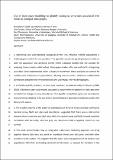Use of state-space modelling to identify ecological covariates associated with trends in pinniped demography
Abstract
1. Identifying and understanding ecological drivers that influence wildlife populations is challenging but critical for conservation. This typically requires integrating long-term data on both the population and potential drivers within statistical models that are suitable for analysing these complex relationships. State-space models offer one method for integrating such data. Once implemented within a Bayesian framework, these analyses can control for multifactorial influences on populations, allowing one to extract otherwise undetectable correlations between the environment and the underlying, inferred demography. 2. In the Moray Firth, Scotland, harbour seals have been counted annually for 30 years (1988?2018). A Bayesian state-space model was used to explore whether patterns in vital rates were correlated to changes in prey abundance, inter-specific competition (grey seal abundance), environmental variables [the North Atlantic Oscillation (NAO) and sea-surface temperature], or level of biotoxins (saxitoxin and domoic acid) in the Moray Firth waters. 3. The credible interval of the posterior distributions of three of these covariate coefficients (sandeel proxy, NAO and grey seal abundance) suggested that there was a relationship between those covariates and vital rates. Both the sandeel proxy and NAO showed a positive correlation with fecundity, whereas grey seal abundance had a negative impact on pup survival. 4. This work demonstrates how an integrated state-space modelling approach can bring together diverse data sets and point to important interactions with prey, and with other predators in the system. This suggests that the wider-scale management of UK harbour seal populations with their contrasting temporal trends needs to account for variation in the marine ecosystem at appropriate spatial scales, in line with current policy concerning spatial planning in the marine environment.
Citation
Caillat , M , Cordes , L , Thompson , P , Matthiopoulos , J & Smout , S 2019 , ' Use of state-space modelling to identify ecological covariates associated with trends in pinniped demography ' , Aquatic Conservation: Marine and Freshwater Ecosystems , vol. 29 , no. S1 , pp. 101-118 . https://doi.org/10.1002/aqc.3130
Publication
Aquatic Conservation: Marine and Freshwater Ecosystems
Status
Peer reviewed
ISSN
1052-7613Type
Journal article
Description
Funding information: Marine Scotland. Grant Number: MMSS/001/11Collections
Items in the St Andrews Research Repository are protected by copyright, with all rights reserved, unless otherwise indicated.

